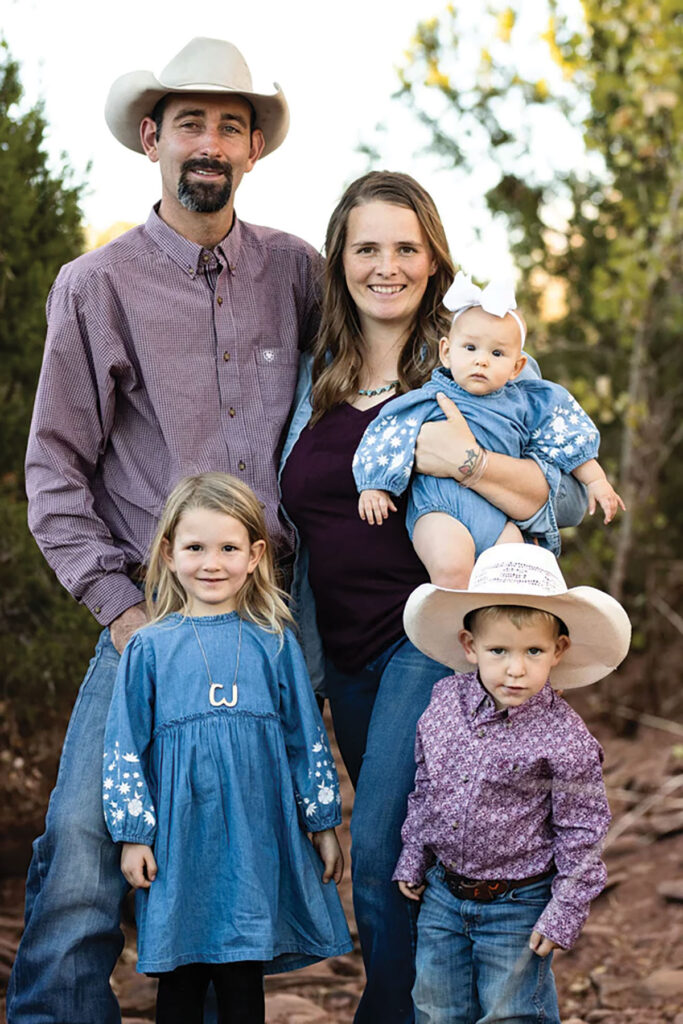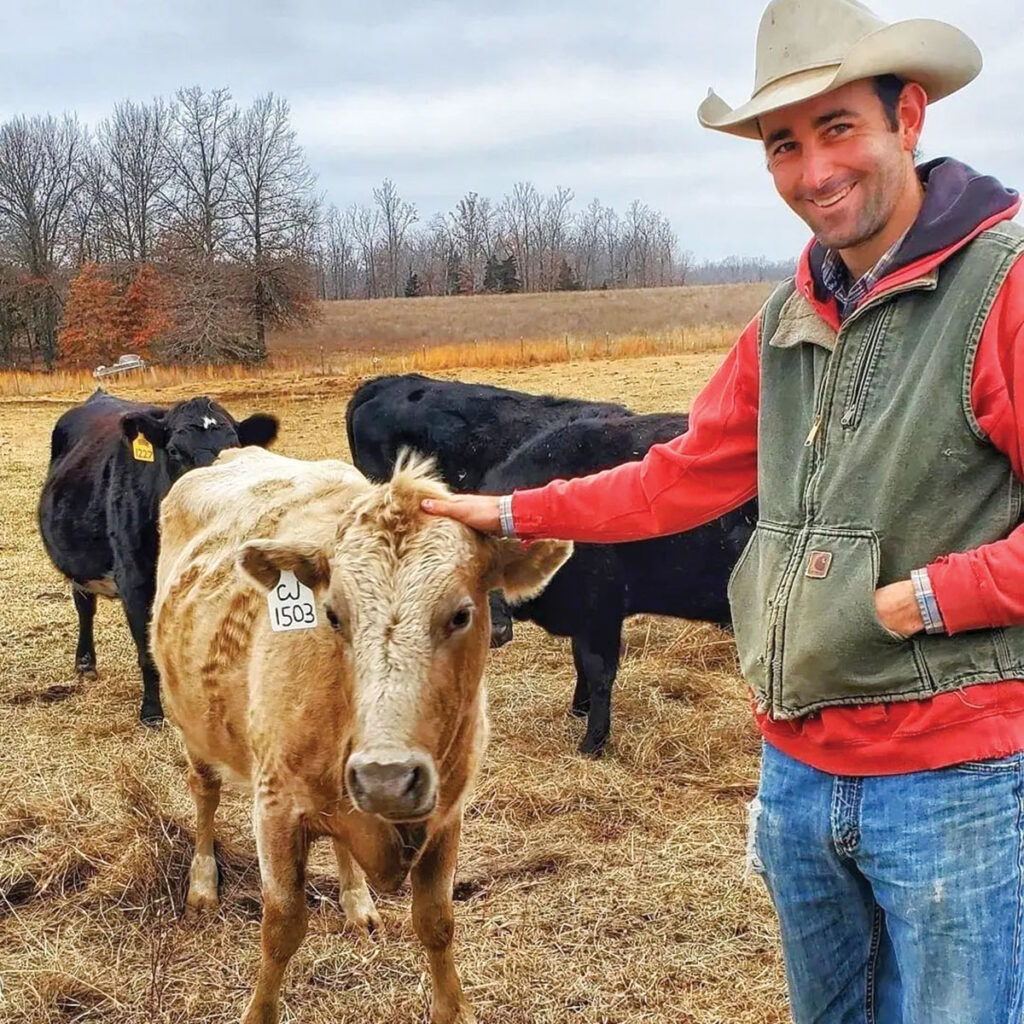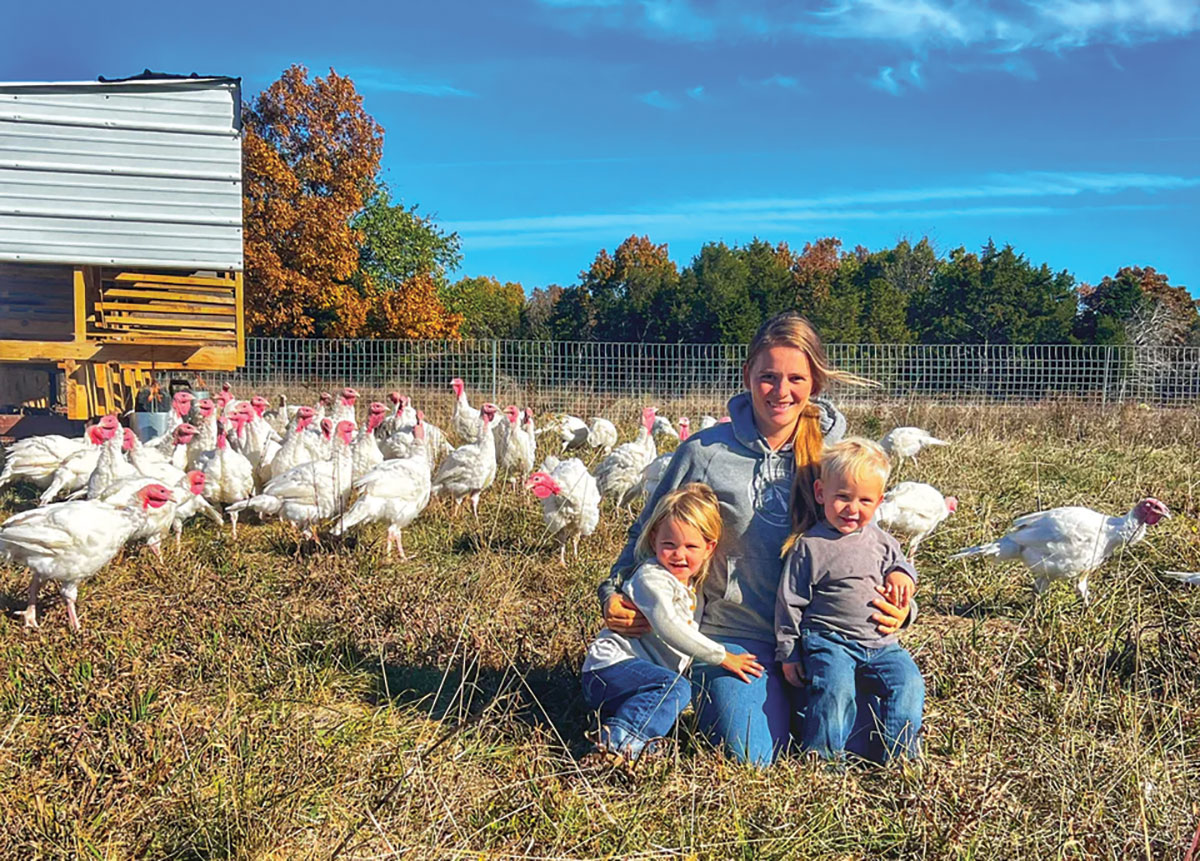
Couple turns to direct marketing to increase their ranch’s revenue
LAMAR, MO. – Cameron and Jacquelyn Whetten tried ranching with Cameron’s family in his native Mexico after they were married, but it was tough.
“There just isn’t enough grass,” Cameron said. “A cow/calf pair can rotationally graze 2, 3 or 5 acres here, but down there, you are lucky to have 40 acres for a pair.”
“I said they grew rocks, not grass,” Jacquelyn added. “You could go out on your horse, ride for eight hours, and not see a cow.”
The couple returned to the Ozarks, where they met when Cameron was a student at Jacquelyn’s parents’ farrier school, Heartland Horseshoeing School, and began their ranch near Lamar, Mo., CJW Pino Ranch.
Cameron and Jacquelyn purchased their first piece of property in 2016 and began growing their ranch.
“We started with some Angus cross heifers and a Beefmaster bull,” Jacquelyn said. “Beefmasters is what Cameron’s family has in Mexico, and we really like the breed. Right now, we are using some Angus or Gelbvieh-cross bulls on our Beefmaster-cross cows. If we raised a herd to simply look at them, we would go with Beefmasters, but for the business, we need black cattle.”
“We aren’t necessarily loyal to any breed,” Cameron added. “We just want something that works. The Beefmaster works well for us until selling time came around. The Beefmaster cow is very hardy, and we have some that are around 16 years old and still producing, but we need that Angus cross on them for the buyers.”
The Whettens and their children, Serina (5), Ady (3) and Brynlee (8 months), currently own 450 acres and run about 80 cow/calf pairs.
In 2020, the couple was trying to figure out how to get more money per head for their calves. They attended a Ranching for Profit seminar, and that’s when they decided to get into direct marketing.
“Now we’re in the meat business,” Cameron said.
Last year, 22 were processed for the meat program, with five going into whole, half and bulk beef sales.
“We have done farmers markets for three years, but we are now transitioning 100 percent to shipping,” Jacquelyn said.
The family was selling farmers markets in Springfield, Mo., and Bentonville, Ark., but that meant at 12 hours away from the farm, with no sales guaranteed.
“We can sell the same amount of meat in four hours,” Cameron said.
CJW Pino Ranch utilizes only steers in the beef program.

Jacquelyn said heifers do not produce the yield they strive for in CJW Pino Ranch Beef.
“We have learned a lot along the way, and heifers are hard to make your money back on because of the yield,” she explained. “It’s amazing what 20 pounds of yield does to your bottom line.”
The Whettens like to process steers at 1,200 to 1,300 pounds.
“We won’t send anything under 1,100 pounds,” Cameron said.
To get those animals to the right weight, they receive a non-GMO corn and alfalfa mix and have access to purchased prairie hay. Calves go into the pasture-based feeding program at about 800 pounds.
Calves are DNA tested for carcass quality.
“They have to have a certain level of tenderness, or we won’t keep them,” Jacquelyn explained. “The ribeye score has been interesting. If they have a good score, they will have that big ribeye, which is very beneficial.”
“That’s where the money is on your steaks,” Cameron said, and added quality feed is also a factor in carcass quality.
“You get all of these EPDs, and you don’t know what you’re going to get until you are ready to process that animal,” Jacquelyn noted. “By that time, you have made decisions for the next three years.”
In addition to sire selection, the Whettens feel their cow families are proven performers.
“We can have a different bull, and we still get the same tenderness,” Cameron said. “An average bull on certain females will still make it to the steak stand.”
DNA results of calves are not culling factors for females, but females that fail to breed or produce a calf that does not grow and thrive are culled.
“If I have to pull a calf, if I have to help a calf along, or if I have to do any of the cow’s job, she’s gone,” Cameron said.
Because of the size of the herd, some calves are sold as feeders.
“We produce more than we can sell in the meat market,” Cameron said. “That’s why having a black calf is beneficial for the pocketbook. We are, however, adding more and more to the meat market each year.”
In addition to beef, the CJW Pino Ranch also offers farm-raised pork, turkey and chicken.
“Sometimes you hear of people doing things, and you think, ‘Oh, I can do that too,’” Jacquelyn said with a laugh.
Cameron said Jacquelyn took a course that promoted raising more than one species, which led to their ranch’s diversification.

“If you do one, you might as well do two more proteins for people to buy from you,” Cameron added. “Jacquelyn wanted to raise 50 chickens for ourselves, but I said if we were going to raise them, we are going to raise them to sell.”
Nine hundred Cornish-cross chickens a year, in batches of 300, are raised in portable “tractors” that are moved around the property, improving the soil and forage quality of that area. Chickens are supplemented with a non-GMO corn, soy and alfalfa-based grower. They are processed at about 5 pounds.
Turkeys are rotated through ungrazed pastures with electrical netting and are offered a non-GMO turkey grower.
“I like to give them deep grass with grasshoppers,” Cameron said. “They get moved once a week. We have a portable roosting area on an old trailer with an automatic waterer.”
Turkeys are marketed around Thanksgiving at a dressed weight of 17 to 20 pounds. Last year, the family raised 75, which Cameron said fits their demand.
Pigs for the pork program are locally-sourced Berkshire pigs purchased at about 40 pounds and are pasture-raised.
“It was a little nerve-wracking to take 10 pigs and put them in a hotwired area and watch them go through the hotwire,” Cameron added with a laugh.
After some trial and error, Cameron and Jacquelyn learned how to train the pigs to the wire, and they are now in a wooded area of the farm.
“Everyone loves bacon,” Cameron said. “They really like pork chops, and we get a lot of good compliments on the marbling of the pork.”
Last year, CJW Pino Ranch processed and sold 36 pigs.
“We typically get batches of 10 or 12, and we like to process them at about 250 pounds; much over that, and your feed ratio is off,” Cameron said. “They will eat more but not put on any weight.”
Pigs also receive non-GMO feed and do their part to improve the ranch
Knowing where their food comes from has been a selling point for many consumers, and the Whettens have welcomed visitors to their farm who want to see how their meat is raised. To promote that connection, Jacquelyn has created a blog and sends out a weekly newsletter about the happenings at the ranch.
Animals on the ranch receive no vaccinations or growth hormones. Cameron and Jacquelyn feel the care they offer their animals and daily pasture rotation keeps their animals disease and parasite-free.
“We see the benefits of rotational grazing, and now that we have water systems in place, this year is going to be a breeze,” Cameron said. “Our pigs, chickens and turkeys are healthy because they get fresh air and are about to be outside.”
Cameron and Jacquelyn stockpile as much grass as possible so they do not harvest hay. What hay they need is purchased, which also aids in reseeding their pastures.
“We bought two loads of Timothy, and where we rolled it out, three years later, we are seeing a very good stand of Timothy,” Cameron said. “When you put up hay, you are taking away nutrients. When I buy hay, I am bringing in nutrients from another farm. Even if hay is $80 a bale, I can’t afford to produce it for that.”
Creating a multi-species meat business took some doing and learning more about the business side of ranching. They also separated the meat business into a different LLC than the ranching operation and calves used in the beef program are purchased from the ranch.
“That way, the meat business isn’t trying to buy hay for the cows,” Cameron said.
Ranching is a family tradition for Cameron and Jacquelyn, and ranching in the Ozarks gives them room to grow their operation and family.
“Even in the hard times, you can’t beat this lifestyle for raising kids,” Jacquelyn said. “I might not see Cameron all day long because he’s out working the farm, but he is still a part of raising the kids. I wouldn’t want him to go off and make a million dollars a year doing something that’s not a part of us.”
“I wasn’t able to go to the family ranch [in Mexico] because there isn’t enough room, animals, or income to support more than one family,” Cameron said. “We’re trying to make our ranch profitable for our children.”







